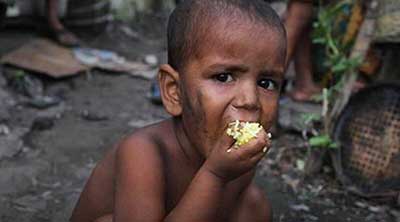Date : 29/09/2023
Relevance – GS Paper 2 – Social Justice
Keywords – Stunting, PMMVY, Socio-economic indicators, POSHAN 2.0
Context
Malnutrition is a global challenge, impacting health, socio-economic indicators, and the environment. The world is facing a nutrition crisis, and India is no exception. The ongoing conflicts and the COVID-19 pandemic have exacerbated this crisis, leading to increased hunger and severe malnutrition. In 2021, an estimated 828 million people experienced hunger, and an additional 924 million faced severe food insecurity, representing a significant increase from previous years. This crisis has particularly severe consequences for vulnerable populations, including women and children.
The Burden of Malnutrition in India:
India bears a substantial burden of malnutrition, with higher rates of stunting (impaired growth) and wasting (acute malnutrition) compared to the Asia region's average. Stunting affects 21.8% of children, while wasting affects 8.9% in India. Undernutrition in children makes them susceptible to infections, hampers recovery, and negatively impacts growth and development. Approximately 45% of deaths among children under five years of age worldwide are linked to poor nutrition, especially in low- and middle-income countries.
South Asia, including India, faces some of the most significant challenges in addressing malnutrition. In 2022, the Global Nutrition Report revealed that India has made progress but still faces significant malnutrition issues, with 34.7% of children under five being stunted, 17.3% wasted, and 1.6% overweight. These rates are higher than the regional averages.
Indian Initiatives to Combat Malnutrition:
India has initiated various programs to combat malnutrition, especially among vulnerable groups. These include the Pradhan Mantri Matru Vandana Yojana (PMMVY), Swachh Bharat Mission, Poshan Vatikas at Anganwadi Centres, and the National Nutrition Mission/POSHAN Abhiyaan. The POSHAN Abhiyaan aimed to reduce stunting, undernutrition, and anemia among young children, women, and adolescent girls, as well as reduce low birth weight. The mission set ambitious targets, including reducing stunting from 38.4% (NFHS-4) to 25% by 2022.
In response to the challenges, the government introduced Mission POSHAN 2.0 in the 2021-2022 budget, focusing on convergence, governance, and capacity-building for integrated nutrition support across all states and union territories. The efforts have shown some success, with the prevalence of malnourishment decreasing as per the National Family Health Survey—NFHS-5 (2019-21). However, the progress varies significantly across states.
State-Wise Variations:
A closer look at the data reveals varying trends in nutritional status across states and union territories. Some states have made significant improvements, while others have stagnated or experienced regression. For instance:

- Dadra & Nagar Haveli and Daman & Diu, Goa, Himachal Pradesh, Lakshadweep, Kerala, Meghalaya, Mizoram, Nagaland, Odisha, Telangana, and Tripura saw an increase in stunting.
- Assam, Bihar, Himachal Pradesh, Jammu and Kashmir, Lakshadweep, Ladakh, Manipur, Mizoram, Nagaland, Telangana, and Tripura witnessed an increase in wasting.
- Andaman and Nicobar Islands, Assam, Dadra & Nagar Haveli and Daman & Diu, Himachal Pradesh, Jammu & Kashmir, Kerala, Lakshadweep, Ladakh, Nagaland, Telangana, and Tripura recorded an increase in being underweight.
- An increase in being overweight was observed in almost all states except for Chhattisgarh, Dadra & Nagar Haveli and Daman & Diu, Goa, and Tamil Nadu.
Women's Nutrition:
Women's nutrition also presents challenges, with Jharkhand having the highest percentage of undernourished women at 26.2%, while Ladakh shows the best performance at 4.4%. Budget allocations and utilization vary across states, with Maharashtra receiving the most significant central fund allocation and showcasing high utilization.
Policy Recommendations:
To address malnutrition effectively, especially at the state level, it's crucial to adopt a data-driven approach. Here are some policy recommendations:
- Data Infrastructure: Establish a robust data infrastructure for real-time monitoring of nutrition indicators at the state level. This will provide insights into the extent of the problem's burden and help tailor interventions accordingly.
- Evidence-Informed Policies: Utilize data insights to inform evidence-based policy interventions. Policymakers should have access to data that highlights specific state-level malnutrition challenges, enabling them to allocate resources effectively.
- Inter-Sectoral Collaboration: Promote inter-sectoral collaboration among diverse actors, including government departments, NGOs, and community organizations. Addressing malnutrition requires a holistic approach, involving multiple stakeholders.
- Tailored Interventions: Develop context-specific interventions based on data-driven insights. Different states may require different strategies to combat malnutrition effectively.
- Policy Advocacy: Use data to advocate for the allocation of funds to address specific nutritional needs. Transparent data on malnutrition can help secure resources for nutrition programs.
- Monitoring and Evaluation: Implement continuous monitoring and evaluation mechanisms to assess the impact of nutrition programs. Regular assessment of data will enable course corrections and improvements in policies and interventions.
Conclusion:
Malnutrition is a pressing issue in India, especially among vulnerable populations like women and children. While the government has initiated various programs to combat malnutrition, progress varies across states. A data-driven, context-specific, and integrated approach is essential to address acute and chronic malnutrition effectively. By using data to inform policies and interventions, promoting inter-sectoral collaboration, and tailoring strategies to specific state-level challenges, India can make significant strides in improving nutrition indicators and ensuring a healthier future for its citizens.
Probable Questions for UPSC Mains Exam
- What are the key factors contributing to malnutrition in India, and how effective have government initiatives like POSHAN Abhiyaan and Mission POSHAN 2.0 been in addressing this issue? Suggest further steps to ensure holistic progress in combating malnutrition in the country. (10 marks, 150 words)
- Explain the significance of a robust data infrastructure for monitoring and addressing malnutrition at the state level in India. Discuss how data-driven policies and inter-sectoral collaboration can help combat malnutrition, and outline the challenges and opportunities in leveraging data for effective policy interventions. (15 marks, 250 words)
Source – ORF







